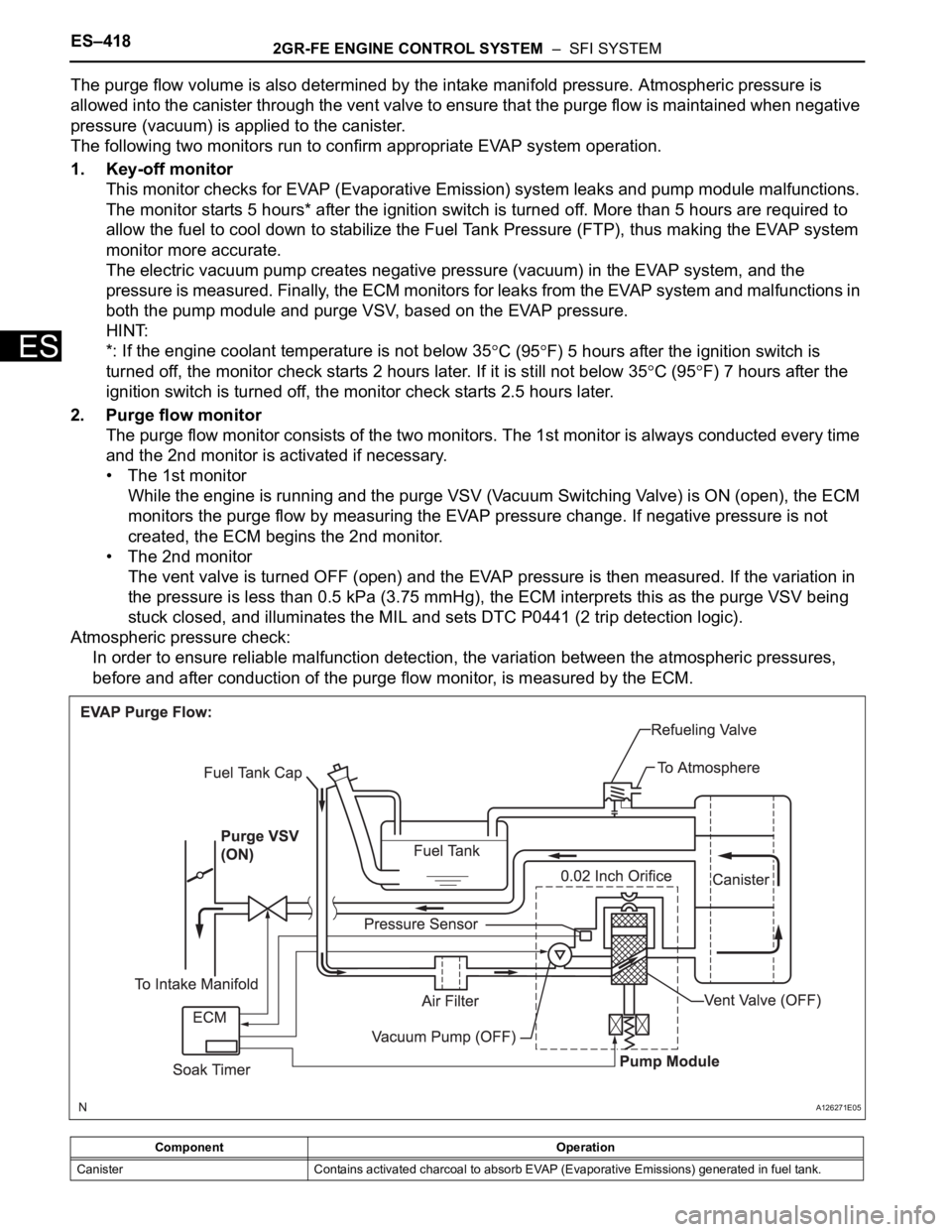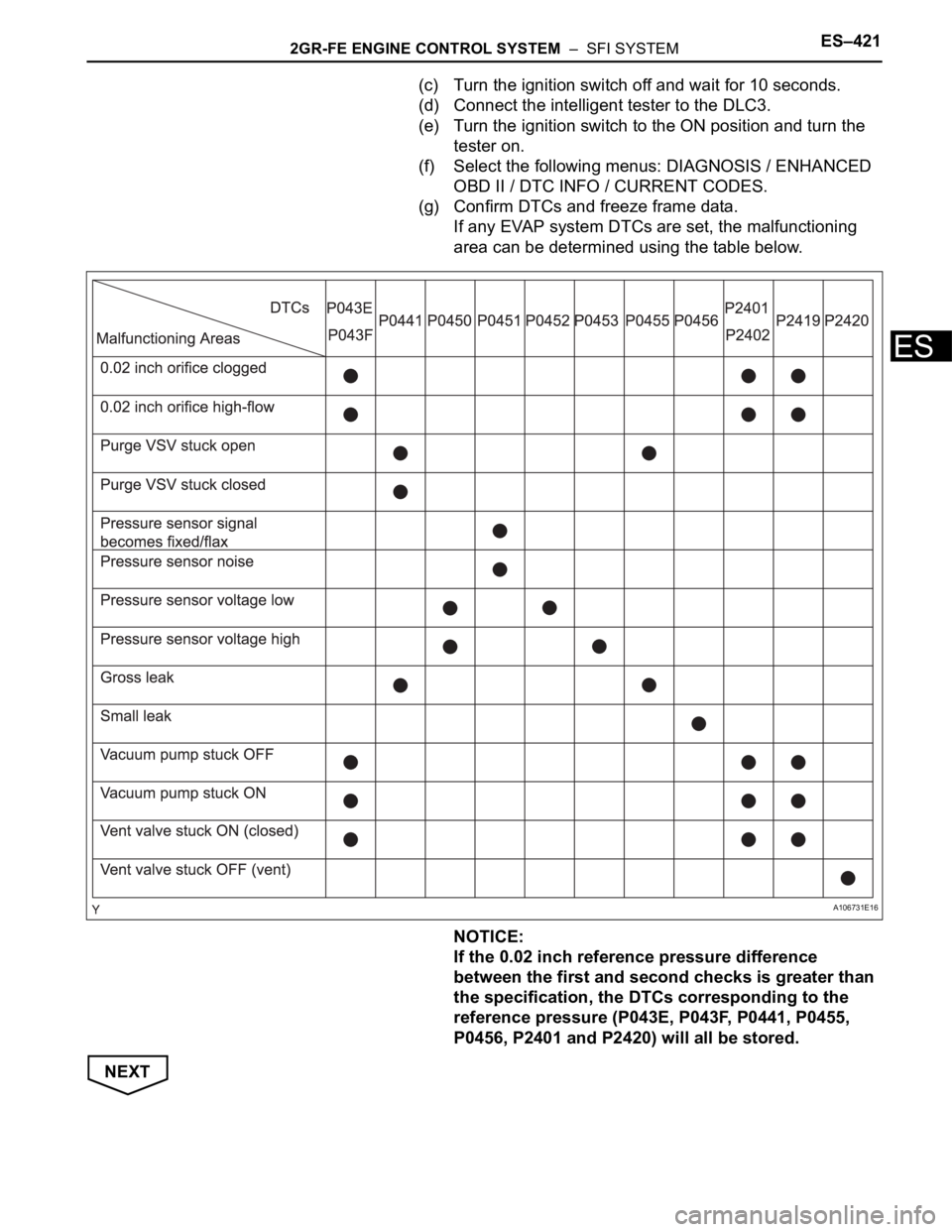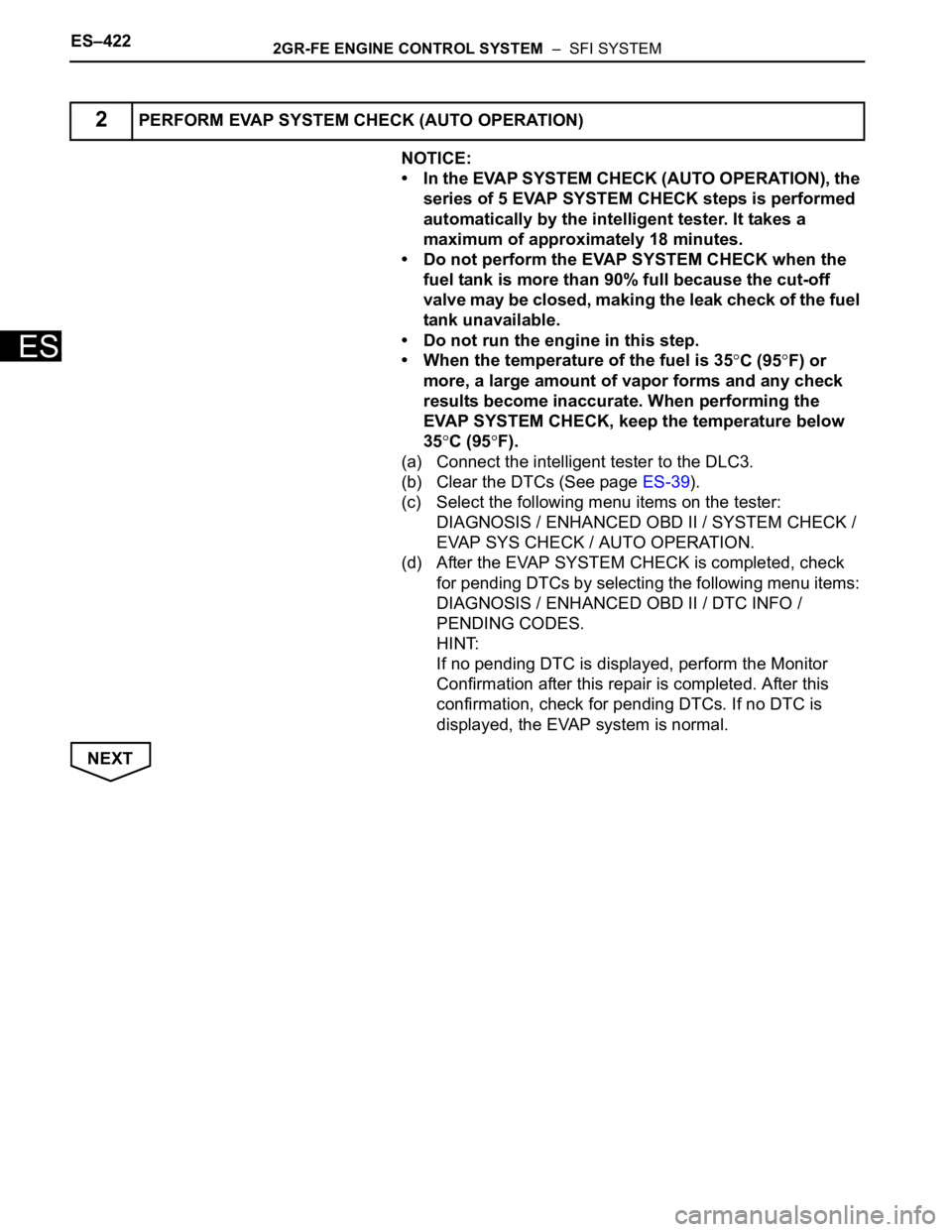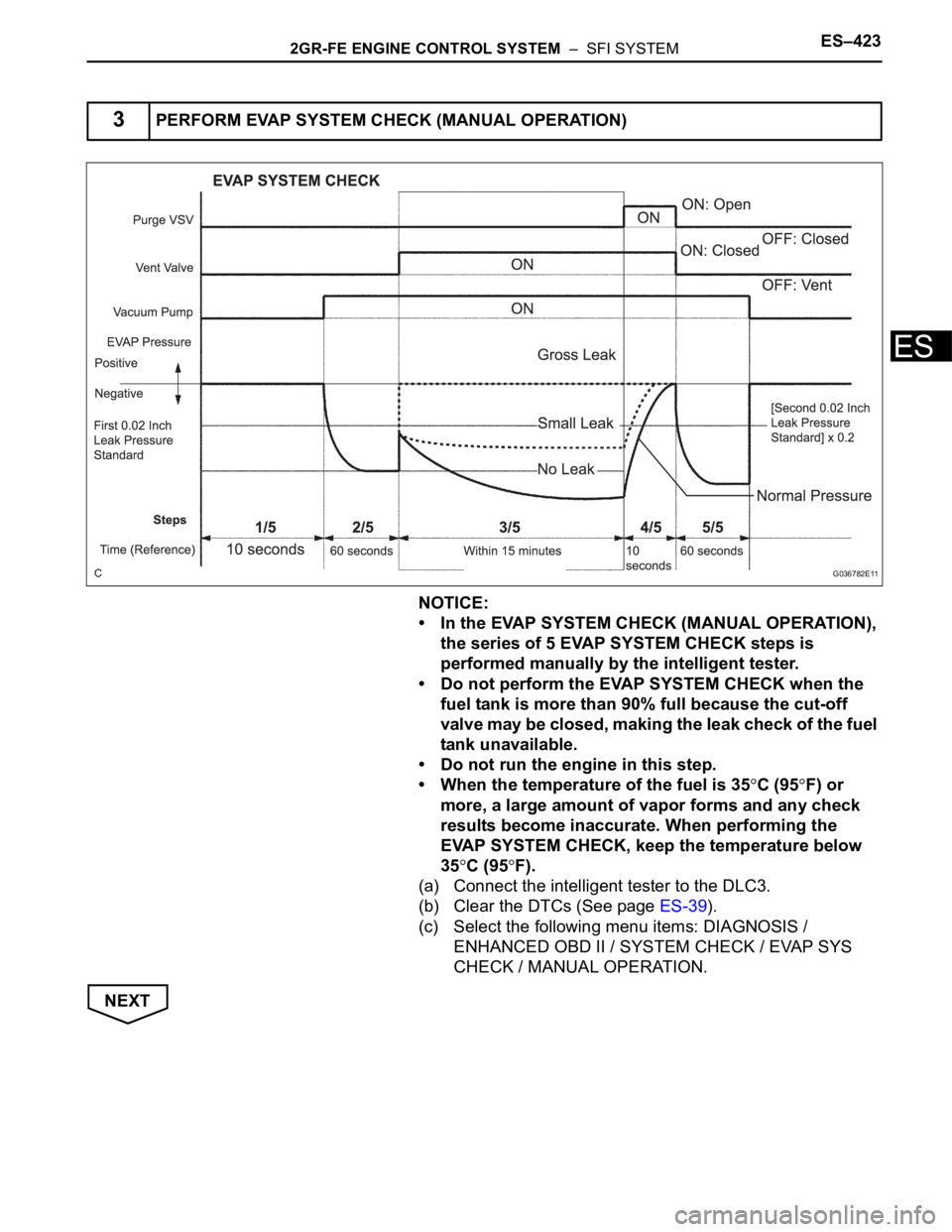2007 TOYOTA SIENNA check engine
[x] Cancel search: check enginePage 699 of 3000

2GR-FE ENGINE CONTROL SYSTEM – SFI SYSTEMES–413
ES
NOTICE:
If the 0.02 inch reference pressure difference between the first and second checks is greater than
the specification, the DTCs corresponding to the reference pressure (P043E, P043F, P0441, P0455,
P0456, P2401, P2420) will be all stored.
CONFIRMATION DRIVING PATTERN
HINT:
After a repair, check Monitor Status by performing the Key-Off Monitor Confirmation and Purge Flow
Monitor Confirmation described below.
1. KEY-OFF MONITOR CONFIRMATION
(a) Preconditions
The monitor will not run unless:
(1) The vehicle has been driven for 10 minutes or more (in a city area or on a freeway)
(2) The fuel tank is less than 90% full
(3) The altitude is less than 8000 ft (2400 m)
(4) The Engine Coolant Temperature (ECT) is between 4.4
C and 35C (40F and 95F)
(5) The Intake Air Temperature (IAT) is between 4.4
C and 35C (40F and 95F)
(6) The vehicle remains stationary (the vehicle speed is 0 mph [0 km/h])
(b) Monitor Conditions
(1) Allow the engine to idle for at least 5 minutes.
A106731E15
Page 700 of 3000

ES–4142GR-FE ENGINE CONTROL SYSTEM – SFI SYSTEM
ES
(2) Turn the ignition switch off and wait for 6 hours (8 or 10.5 hours).
HINT:
Do not start the engine until checking MONITOR STATUS. If the engine is started, the steps
described above must be repeated.
(c) Monitor Status
(1) Connect the intelligent tester to the DLC3.
(2) Turn the ignition switch to the ON position and turn the tester on.
(3) Select the following menu items: DIAGNOSIS / ENHANCED OBD II / MONITOR STATUS.
(4) Check the "Monitor Status" displayed on the tester.
HINT:
If INCMP is displayed, the monitor is not completed. Make sure that the preconditions have
been met, and perform "Monitor Conditions" again.
2. PURGE FLOW MONITOR CONFIRMATION (P0441)
HINT:
Perform this monitor confirmation after the Key-Off Monitor Confirmation shows COMPL (complete).
(a) Preconditions
The monitor will not run unless:
• The vehicle has been driven for 10 minutes or more (in a city area or on a freeway)
• The ECT is between 4.4
C and 35C (40F and 95F)
• The IAT is between 4.4
C and 35C (40F and 95F)
(b) Monitor Conditions
(1) Release the pressure from the fuel tank by removing and reinstalling the fuel tank cap.
(2) Warm the engine up until the ECT reaches more than 75
C (167F).
(3) Increase the engine speed to 3000 rpm once.
(4) Allow the engine to idle and turn the A/C ON for 1 minute.
(c) Monitor Status
(1) Turn the ignition switch off.
(2) Connect the intelligent tester to the DLC3.
(3) Turn the ignition switch to the ON position and turn the tester on.
(4) Select the following menu items: DIAGNOSIS / ENHANCED OBD II / MONITOR STATUS.
(5) Check the "Monitor Status" displayed on the tester.
HINT:
If INCMP is displayed, the monitor is not completed. Make sure that the preconditions have
been met, and perform "Monitor Conditions" again.
MONITOR RESULT
Refer to Checking Monitor Status for detailed information (See page ES-19).
The test value and test limit information are described as shown in the following table. This information is
included in MONITOR RESULT of the emissions-related DTC sections:
– MID (Monitor Identification Data) is assigned to each emissions-related component.
– TID (Test Identification Data) is assigned to each test value.
– Scaling is used to calculate the test value indicated on generic OBD II scan tools.
Thermostat
MID TID Scaling Description of Test Value Minimum Test Limit Maximum Test Limit
$3D $C9 Multiply by 0.01 [kPa]Test value for small leak (P0456)
Refer to pressure D*Minimum test limit for
small leakMaximum test limit for
small leak
$3D $CA Multiply by 0.01 [kPa]Test value for gross leak (P0455)
Refer to pressure E*Minimum test limit for
gross leakMaximum test limit for
gross leak
$3D $CB Multiply by 0.01 [kPa]Test value for vacuum pump stuck OFF
(P2401)
Refer to pressure A*Minimum test limit for
vacuum pump stuck
OFFMaximum test limit for
vacuum pump stuck
OFF
$3D $CD Multiply by 0.01 [kPa]Test value for vacuum pump stuck ON
(P2402)
Refer to pressure A*Minimum test limit for
vacuum pump stuck
ONMaximum test limit for
vacuum pump stuck
ON
Page 704 of 3000

ES–4182GR-FE ENGINE CONTROL SYSTEM – SFI SYSTEM
ES
The purge flow volume is also determined by the intake manifold pressure. Atmospheric pressure is
allowed into the canister through the vent valve to ensure that the purge flow is maintained when negative
pressure (vacuum) is applied to the canister.
The following two monitors run to confirm appropriate EVAP system operation.
1. Key-off monitor
This monitor checks for EVAP (Evaporative Emission) system leaks and pump module malfunctions.
The monitor starts 5 hours* after the ignition switch is turned off. More than 5 hours are required to
allow the fuel to cool down to stabilize the Fuel Tank Pressure (FTP), thus making the EVAP system
monitor more accurate.
The electric vacuum pump creates negative pressure (vacuum) in the EVAP system, and the
pressure is measured. Finally, the ECM monitors for leaks from the EVAP system and malfunctions in
both the pump module and purge VSV, based on the EVAP pressure.
HINT:
*: If the engine coolant temperature is not below 35
C (95F) 5 hours after the ignition switch is
turned off, the monitor check starts 2 hours later. If it is still not below 35
C (95F) 7 hours after the
ignition switch is turned off, the monitor check starts 2.5 hours later.
2. Purge flow monitor
The purge flow monitor consists of the two monitors. The 1st monitor is always conducted every time
and the 2nd monitor is activated if necessary.
• The 1st monitor
While the engine is running and the purge VSV (Vacuum Switching Valve) is ON (open), the ECM
monitors the purge flow by measuring the EVAP pressure change. If negative pressure is not
created, the ECM begins the 2nd monitor.
• The 2nd monitor
The vent valve is turned OFF (open) and the EVAP pressure is then measured. If the variation in
the pressure is less than 0.5 kPa (3.75 mmHg), the ECM interprets this as the purge VSV being
stuck closed, and illuminates the MIL and sets DTC P0441 (2 trip detection logic).
Atmospheric pressure check:
In order to ensure reliable malfunction detection, the variation between the atmospheric pressures,
before and after conduction of the purge flow monitor, is measured by the ECM.
Component Operation
Canister Contains activated charcoal to absorb EVAP (Evaporative Emissions) generated in fuel tank.
A126271E05
Page 705 of 3000

2GR-FE ENGINE CONTROL SYSTEM – SFI SYSTEMES–419
ES
Cut-off valve Located in fuel tank. Valve floats and closes when fuel tank is 100% full.
Purge VSV (Vacuum Switching Valve)Opens or closes line between canister and intake manifold. ECM uses purge VSV to control EVAP
purge flow. In order to discharge EVAP absorbed by canister to intake manifold, ECM opens purge
VSV. EVAP discharge volume to intake manifold is controlled by purge VSV duty cycle ratio
(current-carrying time). (Open: ON, Close: OFF)
Refueling valveControls EVAP pressure from fuel tank to canister. Valve consists of diaphragm, spring and
restrictor (diameter: 0.08 inch). When fuel vapor and pressure inside fuel tank increase, valve
opens. While EVAP is purged, valve closes and restrictor prevents a large amount of vacuum from
affecting pressure in fuel tank. Valve is opened while refueling. When valve is open, adding fuel into
fuel tank is possible.
Roll-over valveLocated in fuel tank. Valve closes by its own weight when vehicle overturns to prevent fuel from
spilling out.
Service port Used for connecting vacuum gauge for inspecting EVAP system.
Soak timerBuilt into ECM. To ensure accurate EVAP monitor, measures 5 hours (+/- 15 min.) after ignition
switch is turned off. This allows fuel to cool down, stabilizing Fuel Tank Pressure (FTP). When
approx. 5 hours elapsed, ECM activates.
Canister pump module Consists of (a) to (d) below. Pump module cannot be disassembled.
(a) Vent valveVents and closes EVAP system. When ECM turns valve ON, EVAP system is closed. When ECM
turns valve OFF, EVAP system is vented. Negative pressure (vacuum) is created in EVAP system
to check for EVAP leaks by closing purge VSV and vent valve (closed), and operating vacuum
pump are turned on (refer to fig. 1).
(b) Canister pressure sensorIndicates pressure as voltages. ECM supplies regulated 5 V to pressure sensor, and uses feedback
from sensor to monitor EVAP system pressure (refer to fig 2).
(c) Vacuum pump Creates negative pressure (vacuum) in EVAP system for leak check.
(d) 0.02 inch orificeHas an opening with 0.02 inch diameter. Vacuum is produced through orifice by closing purge VSV,
turning off vent valve and operating vacuum pump, to monitor 0.02 inch leak pressure. 0.02 inch
leak pressure indicates a small leak of EVAP. Component Operation
Page 707 of 3000

2GR-FE ENGINE CONTROL SYSTEM – SFI SYSTEMES–421
ES
(c) Turn the ignition switch off and wait for 10 seconds.
(d) Connect the intelligent tester to the DLC3.
(e) Turn the ignition switch to the ON position and turn the
tester on.
(f) Select the following menus: DIAGNOSIS / ENHANCED
OBD II / DTC INFO / CURRENT CODES.
(g) Confirm DTCs and freeze frame data.
If any EVAP system DTCs are set, the malfunctioning
area can be determined using the table below.
NOTICE:
If the 0.02 inch reference pressure difference
between the first and second checks is greater than
the specification, the DTCs corresponding to the
reference pressure (P043E, P043F, P0441, P0455,
P0456, P2401 and P2420) will all be stored.
NEXT
A106731E16
Page 708 of 3000

ES–4222GR-FE ENGINE CONTROL SYSTEM – SFI SYSTEM
ES
NOTICE:
• In the EVAP SYSTEM CHECK (AUTO OPERATION), the
series of 5 EVAP SYSTEM CHECK steps is performed
automatically by the intelligent tester. It takes a
maximum of approximately 18 minutes.
• Do not perform the EVAP SYSTEM CHECK when the
fuel tank is more than 90% full because the cut-off
valve may be closed, making the leak check of the fuel
tank unavailable.
• Do not run the engine in this step.
• When the temperature of the fuel is 35
C (95F) or
more, a large amount of vapor forms and any check
results become inaccurate. When performing the
EVAP SYSTEM CHECK, keep the temperature below
35
C (95F).
(a) Connect the intelligent tester to the DLC3.
(b) Clear the DTCs (See page ES-39).
(c) Select the following menu items on the tester:
DIAGNOSIS / ENHANCED OBD II / SYSTEM CHECK /
EVAP SYS CHECK / AUTO OPERATION.
(d) After the EVAP SYSTEM CHECK is completed, check
for pending DTCs by selecting the following menu items:
DIAGNOSIS / ENHANCED OBD II / DTC INFO /
PENDING CODES.
HINT:
If no pending DTC is displayed, perform the Monitor
Confirmation after this repair is completed. After this
confirmation, check for pending DTCs. If no DTC is
displayed, the EVAP system is normal.
NEXT
2PERFORM EVAP SYSTEM CHECK (AUTO OPERATION)
Page 709 of 3000

2GR-FE ENGINE CONTROL SYSTEM – SFI SYSTEMES–423
ES
NOTICE:
• In the EVAP SYSTEM CHECK (MANUAL OPERATION),
the series of 5 EVAP SYSTEM CHECK steps is
performed manually by the intelligent tester.
• Do not perform the EVAP SYSTEM CHECK when the
fuel tank is more than 90% full because the cut-off
valve may be closed, making the leak check of the fuel
tank unavailable.
• Do not run the engine in this step.
• When the temperature of the fuel is 35
C (95F) or
more, a large amount of vapor forms and any check
results become inaccurate. When performing the
EVAP SYSTEM CHECK, keep the temperature below
35
C (95F).
(a) Connect the intelligent tester to the DLC3.
(b) Clear the DTCs (See page ES-39).
(c) Select the following menu items: DIAGNOSIS /
ENHANCED OBD II / SYSTEM CHECK / EVAP SYS
CHECK / MANUAL OPERATION.
NEXT
3PERFORM EVAP SYSTEM CHECK (MANUAL OPERATION)
G036782E11
Page 710 of 3000

ES–4242GR-FE ENGINE CONTROL SYSTEM – SFI SYSTEM
ES
(a) Check the EVAP pressure in step 1/5.
Result
*: The DTCs relating to the EVAP system displayed on
the intelligent tester when checking.
B
A
4PERFORM EVAP SYSTEM CHECK (STEP 1/5)
G036783E06
DTC* Test Result Suspected Trouble Area Proceed to
- Virtually no variation in EVAP pressure Not yet determined A
P0451EVAP pressure fluctuates by +/-0.3 kPa (2.25
mmHg) or morePressure sensor noising B
Go to step 30